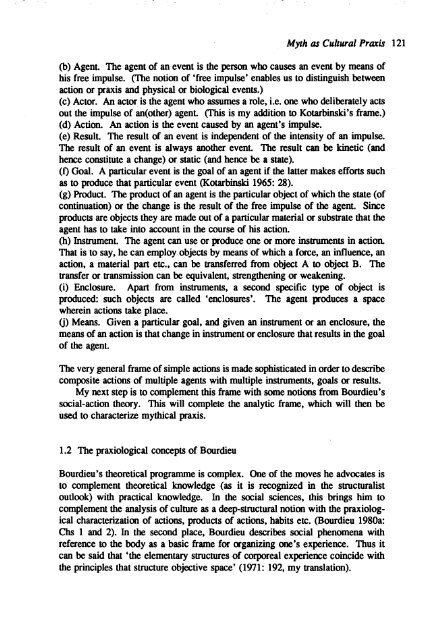1991 No. 1 CONTENTS - Institute of Social and Cultural ...
1991 No. 1 CONTENTS - Institute of Social and Cultural ...
1991 No. 1 CONTENTS - Institute of Social and Cultural ...
Create successful ePaper yourself
Turn your PDF publications into a flip-book with our unique Google optimized e-Paper software.
Myth as <strong>Cultural</strong> Praxis 121<br />
(b) Agent. The agent <strong>of</strong> an event is the person who causes an event by means <strong>of</strong><br />
his free impulse. (The notion <strong>of</strong> 'free impulse' enables us to distinguish between<br />
action or praxis <strong>and</strong> physical or biological events.)<br />
(c) Actor. An actor is the agent who assumes a role, i.e. one who deliberately acts<br />
out the impulse <strong>of</strong> an(other) agent. (This is my addition to Kotarbinski's frame.)<br />
(d) Action. An action is the event caused by an agent's impulse.<br />
(e) Result. The result <strong>of</strong> an event is independent <strong>of</strong> the intensity <strong>of</strong> an impulse.<br />
The result <strong>of</strong> an event is always another event. The result can be kinetic (<strong>and</strong><br />
hence constitute a change) or static (<strong>and</strong> hence be a state).<br />
(0 Goal. A particular event is the goal <strong>of</strong> an agent if the latter makes efforts such<br />
as to produce that particular event (Kotarbinski 1965: 28).<br />
(g) Product. The product <strong>of</strong> an agent is the particular object <strong>of</strong> which the state (<strong>of</strong><br />
continuation) or the change is the result <strong>of</strong> the free impulse <strong>of</strong> the agent. Since<br />
products are objects they are made out <strong>of</strong> a particular material or substrate that the<br />
agent has to take into account in the course <strong>of</strong> his action.<br />
(h) Instrument. The agent can use or produce one or more instruments in action.<br />
That is to say, he can employ objects by means <strong>of</strong> which a force, an influence, an<br />
action, a material part etc., can be transferred from object A to object B. The<br />
transfer or transmission can be equivalent, strengthening or weakening.<br />
(i) Enclosure. Apart from instruments, a second specific type <strong>of</strong> object is<br />
produced: such objects are called 'enclosures'. The agent produces a space<br />
wherein actions take place.<br />
(j) Means. Given a particular goal, <strong>and</strong> given an instrument or an enclosure, the<br />
means <strong>of</strong> an action is that change in instrument or enclosure that results in the goal<br />
<strong>of</strong> the agent.<br />
The very general frame <strong>of</strong> simple actions is made sophisticated in order to describe<br />
composite actions <strong>of</strong> multiple agents with multiple instruments, goals or results.<br />
My next step is to complement this frame with some notions from Bourdieu's<br />
social-action theory. This will complete the analytic frame, which will then be<br />
used to characterize mythical praxis.<br />
1.2 The praxiological concepts <strong>of</strong> Bourdieu<br />
Bourdieu's theoretical programme is complex. One <strong>of</strong> the moves he advocates is<br />
to complement theoretical knowledge (as it is recognized in the structuralist<br />
outlook) with practical knowledge. In the social sciences, this brings him to<br />
complement the analysis <strong>of</strong> culture as a deep-structural notion with the praxiological<br />
characterization <strong>of</strong> actions, products <strong>of</strong> actions, habits etc. (Bourdieu 1980a:<br />
Chs 1 <strong>and</strong> 2). In the second place, Bourdieu describes social phenomena with<br />
reference to the body as a basic frame for organizing one's experience. Thus it<br />
can be said that 'the elementary structures <strong>of</strong> corporeal experience coincide with<br />
the principles that structure objective space' (IrrJl: 192, my translation).
















